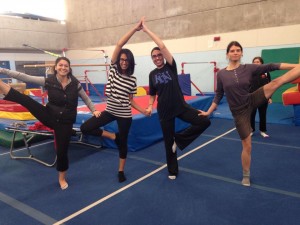How do I plan for a quality physical education (PE) program?
In order to plan for a quality PE program, teachers need to ask themselves what it is that they want their students to learn, how they plan on assessing whether or not students have properly learned their lesson, and how they are going to initiate and carry out students’ understandings. So, as this demonstrates, planning, teaching, and evaluating are the steps involved in the instructional process. Another aspect of establishing a quality PE program is evaluating the individual strengths and requirements of students in order to determine any modification that should be made to lessons. Each province provides teachers with curriculum documents outlining specific learning outcomes for each grade. These guidelines help teachers with the planning process about what it is they should expect students to learn. The curriculum documents are very general, allowing for teachers to be creative and individualize their lessons. Effective teachers will design lessons that will be the most beneficial for their groups of students, taking into account their various interests and needs. Furthermore, teachers need to take into consideration the school’s policies and values. Some schools may be more sports bases whereas others will place more focus on movement and games. Being mindful to stay away from “hall of shame” activities, ensuring that each lesson is inclusive and meaningful is yet another factor in developing quality PE programs.
What are the steps to the Instructional Process?
The instruction process discussed in ch.5 begins with establishing a safe (emotionally, physically, and mentally) environment that meets the needs of individual students while fulfilling the prescribed learning outcomes of the provincial curriculum. This requires teachers to be flexible with their plans, allowing for students to play a role in the process and adapting lessons to meet their needs. This will also encourage the active engagement of students, building up on their intrinsic motivation for PE. Furthermore, the text highlights the point that, “outstanding physical educators implicitly and explicitly address the affective learning domain, recognizing that teaching is about developing positive relationships with and among students” (Robinson & Randall, p.78).
A crucial step towards developing positive relationships involves effective communication skills. The textbook highlights key communication skills such as “clarity, demonstration and visual aids, cues, questioning, observation, and feedback” (Robinson & Randall, p.79). Not only do these skills help to establish positive relationships in class, but they also help enhance meaning making and understanding. Furthermore, through positive communication strategies and relationship building, students will become more engaged in activities, which is crucial for accomplishing the stated goals of a lesson.
The instructional framework is another key element in the instructional process. The steps involved are: The introductory phase (warm-ups and overview); New skills phase (explanation/demonstration); Consolidation phase (students practice and teachers give feedback); Application phase (apply new skills in a more independent setting); Closure (students are provided feedback on the activities) (Robinson & Randall, p.87).
What are the different teaching styles?
The textbook outlines the 11 different teaching styles proposed by Mosston and Ashworth (2001).
Command style of is teacher-directed where the teacher delivers the instructions to learners and the students are expected to respond accordingly. This is a very straightforward approach that follows the teacher’s plan very closely. “Teacher feedback is limited” (Robinson & Randall, p.88) with this type of instruction, maximizing the students time on task.
Practice style is a slightly less teacher-directed approach. In this teaching style, learners are given slightly more independence by allowing for them to set their own pace for activity time. There is more of a focus on individual practice and the teacher provides students with individual feedback.
Reciprocal style is more social in nature. In this type of teaching style, the students are grouped in two’s or three’s. One student does activities while the other(s) observe and give feedback rather than the teacher providing feedback. Although the teacher communicates with the student who are observing, they mostly place responsibility in the hands of students.
A Self-Check style is when students assess themselves as opposed to teacher assessment. This allows for the students to gain a better understanding on their own personal strengths, weaknesses, and progress. Teachers provide feedback for students at the end of a lesson.
Inclusion style takes account of the varying abilities in a group. This teaching style allows for accommodations to be made in order to increase or decrease the complexity of an activity in order to meet individual’s needs. This is a more self-assessed/directed style of teaching.
The remaining teaching styles are inquiry-teaching styles. They range on a spectrum from Guided Discovery to Self-teaching. A Guided Discovery style, teachers guide students through a series of steps, offering frequent feedback and working along with the students throughout the process. Convergent Discovery style involved the teacher presenting the problem/task and the students figure out the process. Whereas Convergent Discovery style involves only one solution to a problem, Divergent Discovery style considers many different solutions to a problem. In this teaching style, teachers may model one response but mostly encourage students’ responses to the problem. Learner-Designed Individual Program style allows students to take control of their learning experiences under the teacher’s broad topic area. Learner-initiated style is when the learners make all of the decisions and the teacher is a facilitative resource. Self-teaching style is when the student is the teacher (and is “outside the realm of physical education classes”(p.89).

